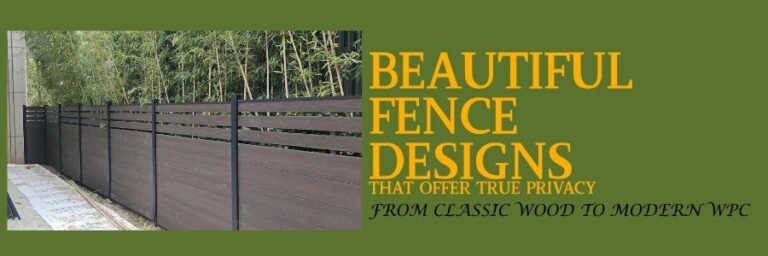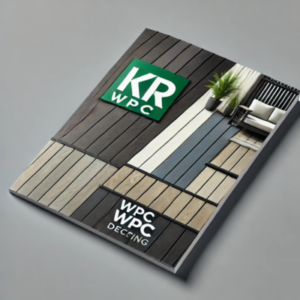Introduction: The Role of Fencing in Modern Outdoor Design
A good fence does more than draw a line around your yard. It sets the mood, filters noise, frames your landscaping, and quietly nudges property value in the right direction. It’s your garden’s picture frame and your patio’s bodyguard in one.
You’ve probably noticed the trade‑offs. Traditional wood looks warm and welcoming, but it asks for regular staining, sealing, and the occasional weekend you’d rather spend by the grill. Newer materials promise less upkeep and more longevity, but will they look “natural” and actually feel like home?
That’s where modern WPC (wood‑plastic composite) fencing earns a spot at your table. With brands like KR WPC, you get the wood look you love and the weather resistance you need—so the fence works harder while you relax. KR WPC’s lineup even includes co‑extruded slat panels, semi‑privacy options, and accessories like solar LED post kits to finish the look.
Running late, the idea still stuck: you wanted real privacy without a bunker vibe. Let’s map out the designs that do exactly that.
Classic Wood Fence Styles and Their Appeal
Below are the familiar favorites—plus a quick take on how each can translate to modern composite builds if you want the same vibe with less upkeep.
- Picket Fence — Timeless and Welcoming
- Best for front yards and cottage gardens where “friendly but defined” is the goal.
- Low heights keep sightlines open, so you can wave to neighbors and still corral pets.
- Adjustable spacing between pickets lets you tweak the feel from airy to semi‑private.
- Board‑on‑Board Fence — Designed for Full Privacy
- Overlapping vertical boards eliminate gaps, even when wood shrinks or swells.
- Great at softening street noise and screening side‑yard views.
- Looks substantial and classic—think “private retreat” around patios and hot tubs.
- Shadow Box Fence — A Blend of Privacy and Airflow
- Alternating boards on either side of the rails create depth and peek‑through airflow.
- From the street, you get privacy; from up close, it feels lighter and more architectural.
- Often a neighbor‑friendly choice on shared property lines.
- Horizontal Slat Fence — The Modern Trendsetter
- Clean lines, wide boards, and a calm, contemporary presence.
- Makes small yards look wider (horizontal lines visually stretch the space).
- Works beautifully with composites like KR WPC slats if you want the same look with lower maintenance and consistent color.
Privacy‑Focused Fence Designs
When privacy is priority one, a few design families are your go‑tos. Here’s how they stack up in looks, airflow, and adaptability.
- Solid Panel Fences
- The privacy powerhouse—ideal for urban lots or along busy roads.
- Add decorative top trim, a lattice extension, or a slim lighted cap to soften the profile.
- In composite, you’ll see consistent color and fewer long‑term gaps or warps.

- Louvered and Semi‑Private Fences
- Angled boards obscure direct sightlines yet invite breezes, perfect around pools and patios.
- Great compromise where you want airflow, light, and a sense of separation.
- KR WPC and similar systems often include semi‑privacy slat panels that pair with full‑privacy sections for a layered look.
- Combination Fences
- Mix materials—wood posts with metal frames and WPC infill—if you want modern texture and strength.
- Try solid on the lower half (privacy where you sit) and more open above to keep the sky in view.
- Aluminum frames plus WPC boards are a popular DIY‑friendly combo for straight, stable sections over time.

Simple guide you can screenshot:
Privacy vs. Airflow quick chart
- Solid panel: Privacy 5/5, Airflow 1/5
- Board‑on‑board: Privacy 5/5, Airflow 2/5
- Shadow box: Privacy 4/5, Airflow 3/5
- Louvered/semi‑private: Privacy 3–4/5, Airflow 4/5
- Picket: Privacy 1–2/5, Airflow 5/5

Moving Beyond Traditional Wood: The Rise of WPC Fencing
What Is WPC (Wood‑Plastic Composite)?
- In plain English: WPC blends wood fibers with plastic polymers, then extrudes the mix into boards or panels that look like wood but shrug off many of wood’s headaches. Typical recipes use recycled wood and HDPE or similar plastics.
- As one succinct expert line puts it, “WPCs do not corrode and are highly resistant to rot, decay.”
Why Homeowners Are Switching to KR WPC Fencing
- Low maintenance
- You can skip the staining/painting cycle that wood fences demand. As Consumer Reports notes (about outdoor composites), “[composite decking] doesn’t ever need to be sealed, stained, or painted.” The same low‑maintenance DNA applies to composite fence boards.
- Long lifespan and color consistency
- Composites are engineered for weathering and UV exposure; KR WPC highlights UV inhibitors in its outdoor lines to hold color longer.
- Built‑in durability
- Research from the U.S. Forest Service’s Forest Products Laboratory has long discussed WPC durability mechanisms and weathering behavior, reinforcing why composites perform in outdoor use.
Design Flexibility
- Colors, grains, and patterns
- KR WPC’s fence boards come in popular neutrals (chocolate, oak brown, dark gray, black, light gray), with embossed wood grain or brushed textures for a matte, modern look.
- Style matches
- Love board‑on‑board or the horizontal slat aesthetic? KR’s co‑extruded slat panels and semi‑privacy modules are designed to replicate those profiles—minus most of the upkeep.
- Smart add‑ons
- Prefer a finished, resort‑style glow? KR WPC lists composite fence options that pair with solar LED kits for subtle, wire‑free lighting. Nice for evening patio time.
A quick note on warranties and materials
- KR WPC states warranties up to 25 years across product lines and details certifications such as ISO 9001, CE, and FSC. Individual fence boards (like the KRWB‑16120 hollow board) list a 15‑year warranty and a typical composition around 60% wood fiber, 30% HDPE, and 10% additives.
Choosing the Right Fence for Your Space
Consider Purpose First
Ask yourself: Is the fence primarily for privacy, a friendly boundary, pet safety, wind control, or curb appeal? Your “why” picks the winner:
- Maximum seclusion near a hot tub? Solid panel or board‑on‑board.
- Breezy patio you still want screened? Louvered or shadow box.
- Front yard charm? Lower pickets or spaced horizontal slats.
Match Aesthetics to Architecture
- Modern or mid‑century homes: Horizontal WPC slats in a warm brown or cool gray keep the facade sleek.
- Traditional or Craftsman: Vertical paneling, classic caps, and a natural wood‑tone composite bring harmony.
- Big lot? Vary patterns—use solid near seating areas and semi‑private sections along long runs to add rhythm.
Balance Cost and Maintenance
- Wood is often cheaper on day one but costs time and supplies over the years. Many homeowners restain every 2–3 years to manage UV and moisture exposure; the frequency varies by climate and finish.
- WPC typically costs more upfront but pays you back in weekends saved, fewer repairs, and long‑term appearance. Consumer Reports’ composite testing underscores that low‑maintenance advantage across outdoor applications.
Environmental Considerations
- WPC commonly incorporates recycled wood and plastic, which helps reduce demand for virgin materials. The U.S. EPA notes that recycling conserves resources and lowers greenhouse gas emissions relative to landfilling—part of why recycled content in building products matters.
- Some advanced recycling pathways are also lowering the carbon footprint of plastics, pointing to a cleaner feedstock future for composites.
Local Codes, Heights, and Where That Extra 6 Inches Goes
- Backyard privacy fences in many U.S. cities top out around 6 feet, while front‑yard fences are often limited to roughly 3–4 feet. Always check your city, HOA, and corner‑lot visibility rules. For example, Airway Heights, WA caps residential fences at 6 feet outside the front setback, and San Pablo, CA’s table lists 6 feet in rear or interior side yards.
Handy Comparison: Classic Wood vs. KR WPC
| Factor | Classic Wood | KR WPC Composite |
| Look & feel | Warm, authentic grain | Realistic wood tones/grain embossing |
| Upkeep | Stain/seal every few years; replace boards as needed | Soap‑and‑water cleaning; no staining or painting needed |
| Gaps/warping over time | Possible with weather cycles | Engineered for stability; less warp, consistent spacing (system‑based) |
| Lifespan (typical) | Cedar often 15–25 years with care; pine 10–15 | Long service life; color stability aided by UV inhibitors; product warranties up to 25 years depending on line |
| Styles available | All traditional styles | Can replicate board‑on‑board, horizontal, and solid panels; semi‑privacy slats available |
| Sustainability | Renewable, but requires coatings/upkeep products | Often uses recycled inputs; fewer coatings over time; see EPA recycling benefits |
Crazy, right? You can keep the look you love and skip half the chores.
Real‑World Scenes You Can Steal
- Tight city patio: Mix 70% solid panels for privacy with a 30% louvered top. Add slim solar‑lit caps on posts to edge the space with a resort glow.
- Long suburban side yard: Alternate solid WPC bays with semi‑private bays to break up the run; it reads custom without custom prices.
- Front garden: Low, horizontal slats in a warm oak‑brown composite—inviting but tidy—paired with native grasses and a simple steel mailbox.

Conclusion: Blending Beauty, Privacy, and Practicality
Your fence should earn its keep. It should feel like part of the landscape, hush the world a bit, and stand up to the weather without demanding a standing appointment on your calendar.
If you adore the coziness of wood and don’t mind a brush and a weekend, classic styles will always have a place. But if you want the natural look with “set-it-and-forget-it” energy, KR WPC, a leading composite fencing supplier, offers that sweet spot—elegant lines, true privacy, and fewer chores. With modern colors, realistic grains, semi-privacy modules, and even solar-lit finishing touches, you can build the kind of backyard that makes you stay for one more cup of coffee.
FAQ
Q: Which fence design offers both airflow and privacy?
A: Louvered and shadow‑box designs excel here. Louvers block direct sightlines while letting breezes through—great around patios and pools. Semi‑private composite slats can deliver a similar effect with less upkeep.
Q: How long do wood fences last compared to composite ones?
A: Expect many cedar fences to run 15–25 years with periodic sealing; pressure‑treated pine is often 10–15. Composites are engineered for longevity and weather resistance and typically require far less maintenance; KR WPC references long warranties and UV stabilization across lines. Always compare product warranty terms.
Q: Are horizontal wood fences more expensive than vertical ones?
A: Often, yes—horizontal builds can need beefier framing to keep long runs straight. In composite systems, horizontal slats are common and can help maintain crisp lines over time because the boards and brackets are designed to work together.
Q: What is the best fence style for a small backyard?
A: Horizontal slats visually widen narrow spaces. Keep posts and caps simple, and consider mixing a solid lower section (for seated privacy) with a lighter top to preserve daylight. Semi‑private WPC slats are great for this.
Q: What are the advantages of WPC over traditional wood fencing?
A: Fewer maintenance tasks, strong resistance to rot and insects, stable color, and design flexibility. WPC’s recycled content is another plus; the EPA outlines how recycling conserves resources and reduces emissions, which is part of the appeal of composite products that use recycled inputs.








